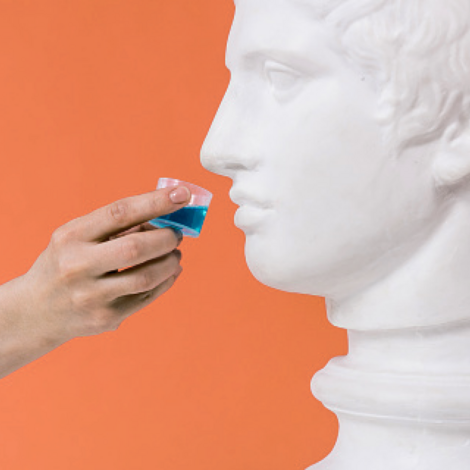There is a portal to the dream world, flickering open and closed in the commercial breaks between episodes of The Real Housewives in the Peacock app, and always in proximity to the promise of domestic bliss.
In their recent marketing, insurance companies Progressive and State Farm, as well as non-insurance companies such as Wayfair and Verizon, have chosen a popular filming location in a corridor of a Universal Studios back lot that resembles a suburban neighborhood—originally laid out for the 1989 Tom Hanks movie The ’Burbs. It has since appeared in decades of programming, from horror movies to Super Bowl spots, but hundreds of millions of people would recognize even a sliver of it, with the decisive and instantaneous understanding a child feels beholding their mother for the first time, as Wisteria Lane, the setting for ABC’s Desperate Housewives.
More than 20 years after it originally aired, the legacy of Desperate Housewives remains visible everywhere, not just in Peacock’s advertising blocks but in its programming, which now documents Housewives all over the world and generates boatloads of dollars while doing so. The housewife remains the personification of the American conservative matriarch—her look may change radically, but her feminine and familial values remain the same. As I discovered when I revisited the show today, what used to qualify as prime-time melodrama now feels a little too real.
Desperate Housewives spanned eight seasons, each one centered on the same cul-de-sac in a dreamlike realm in some sunny corner of the contiguous United States: the town of Fairview in “Eagle State,” written in cursive on license plates. People moved there from New York or Chicago with the hopes of settling into a suburban fantasy, only to discover their neighbors were murderers, abusers, or garden-variety sociopaths. Marc Cherry, the show’s creator, said that he chose “Wisteria Lane” for its mellifluousness and only later learned of the flower’s tendency to look gorgeous on the outside while wreaking botanical havoc at the root level. Every aesthetic choice reaffirmed the show’s motif of ah, but underneath. (Just about every episode is named for a Stephen Sondheim song or lyric.)
But the centerpiece bouquet of Desperate Housewives was its four matriarchs, who, in the show’s backstory, had moved to Wisteria Lane at inflection points in their lives before converging into a casual poker-night friend group.
When the show premiered in 2004, American culture was sprawling outward—suburbs were booming, with Black and Hispanic families accounting for the largest suburban growth rates in the nation’s history. Then the sprawl spread online, a realm that developed its own domestic goddess: the “tradwife,” a subset of TikTok influencers who adopt the cosplay of homesteaders, reaching beyond the 1950s housewife toward pastoral fantasies of moisturizing with beef tallow and making peanut butter and jelly from scratch.
According to Pew Research, the proportion of stay-at-home moms rose in the years leading up to and following the Great Recession; by 2012, about a third of American mothers did not work outside the home. Meanwhile, the housewife was slowly elevated into an aspirational figure; soon, the women of Wisteria Lane were teetering down their street in Louboutin Daffodiles. (Even Felicity Huffman as Lynette, the harried mother of four, then five, then six children, would find herself in Gucci from time to time.) Though the show’s myriad plotlines were predicated on the unrelenting turmoil of these women’s inner lives, just as important was the manicured image they projected. It was the distance between the two that provided entertainment. The very first episode has the actress Brenda Strong calmly narrating how her character, Mary Alice, spent her morning, which began with household errands and ended with her suicide. As a young, suburb-bound closet case, it took seconds—if that long—for my obsession to flourish.
Before long, the show adopted a procedural cadence. Each season would begin with a new and mysterious neighbor, whose secret would unfold slowly toward a climactic finale. A nonzero part of my childhood is intertwined with Desperate Housewives, for maybe better and almost certainly worse. There was the summer I spent in a malaise after the Season Four cliffhanger when Edie, the Biblical slut played by Nicollette Sheridan, appeared to hang herself. (I loved Edie so much. “Nicollette Sheridan Edie Britt contract renew season five?,” I googled—desperately—for three months.) I can say, 20 years after the show’s premiere, that I have retained a preternatural spatial awareness of Wisteria Lane’s homes, having spent hours upon hours building replicas of them in The Sims.
There are 180 episodes of Desperate Housewives, and I’ve seen all of them twice and some of them upwards of 10 times. The plotlines ranged from tender to gripping to phantasmagoric, but the show kept its poise thanks to its main cast, who should receive military honors for what they did with the material they were given, and thanks to its recurring setting, which always brought us home.
You could contrast this with the latest primetime program inspired by Desperate Housewives: NBC’s Grosse Point Garden Society, which is rooted in a real place (the titular affluent Detroit suburb) and yet grounded nowhere. Most scenes take place either indoors or in one particular garden plot, giving viewers no place to rest our imaginations as we’re rocketed between the present day and the blue-tinged “six months earlier” flashbacks that set up the show’s murder mystery.
The point of Desperate Housewives was the suburban community, and how the women would defy it for their own interests—lying, stealing, or maiming to protect families, images, or composure. The first season captured an average of 20-some million viewers per episode. One of them was Scott Dunlop, an advertising executive who pitched a reality-TV show set in his gated community that became The Real Housewives of Orange County, and the subsequent constellation of Bravo’s Real Housewives programs, 19 years ago this month.
The earliest episodes of Orange County, New York, and Atlanta felt like documentary footage of affluent American life; more recently, the show’s cinéma vérité arrives in a thick and intractable layer of gloss. The women of Wisteria Lane were rich but would look like ordinary Americans next to the ladies of Beverly Hills and Salt Lake City, for whom first-class flights are basic necessities. (In 20 short years, what one considers wealthy has vaulted upward.) Since the Housewives were added to NBC’s Peacock app, they’ve generated some $300 million for the streaming service. They’ve also charted a new path to reality-TV stardom, one that requires them to engage in and broadcast their own batshit storylines—their marriage failures, substance dependencies, and fraud convictions. Less real, more desperate, just like their foremothers.
It’s a little amazing that the Desperate Housewives cast hasn’t yet reconvened for some rebooted special or insurance cameo, a fact that may have to do with Felicity Huffman’s conviction for college-admissions fraud—something Lynette would have done! Perhaps we don’t need more Desperate Housewives because we already have more than enough on television. The show ended with a postscript explaining each main character’s happily-ever-after, and Wisteria Lane moved on to other projects. Gabrielle’s house, once sunbeam yellow, is now a pallid green; Bree’s flower beds have been paved over; Edie’s lot has been razed.
Now, when I catch a glimpse of a familiar curb in an advertisement, I am suddenly and inside-twistingly whisked back to that dreamworld, only to be returned to Real Housewives programming. I become acutely aware of my body shooting through Bravo and NBC’s mighty marketing funnel, and nausea blooms in my stomach. But in an instant, sickness is replaced by sadness. As the portal flickers closed, I can catch a glimpse of a place I used to love that is still there and also no longer exists.
Brennan Kilbane is a New York–based writer and the beauty editor at The Business of Fashion. He is originally from Cleveland, and his interviews and essays have appeared in Allure, GQ, and New York





